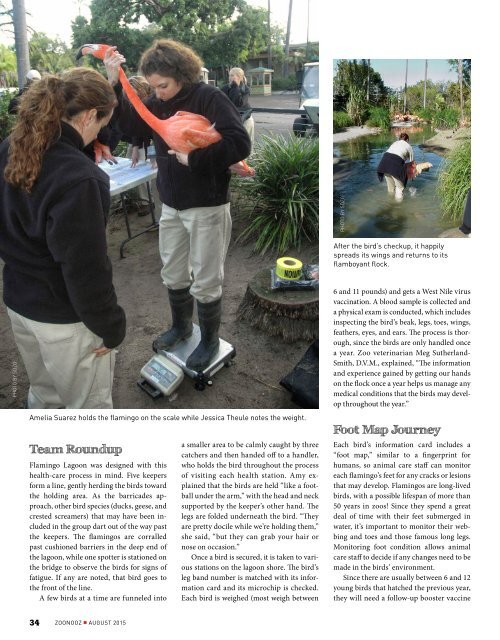You also want an ePaper? Increase the reach of your titles
YUMPU automatically turns print PDFs into web optimized ePapers that Google loves.
PHOTO BY SDZG<br />
After the bird’s checkup, it happily<br />
spreads its wings and returns to its<br />
flamboyant flock.<br />
PHOTO BY SDZG<br />
6 and 11 pounds) and gets a West Nile virus<br />
vaccination. A blood sample is collected and<br />
a physical exam is conducted, which includes<br />
inspecting the bird’s beak, legs, toes, wings,<br />
feathers, eyes, and ears. The process is thorough,<br />
since the birds are only handled once<br />
a year. Zoo veterinarian Meg Sutherland-<br />
Smith, D.V.M., explained, “The information<br />
and experience gained by getting our hands<br />
on the flock once a year helps us manage any<br />
medical conditions that the birds may develop<br />
throughout the year.”<br />
Amelia Suarez holds the flamingo on the scale while Jessica Theule notes the weight.<br />
Team Roundup<br />
Flamingo Lagoon was designed with this<br />
health-care process in mind. Five keepers<br />
form a line, gently herding the birds toward<br />
the holding area. As the barricades approach,<br />
other bird species (ducks, geese, and<br />
crested screamers) that may have been included<br />
in the group dart out of the way past<br />
the keepers. The flamingos are corralled<br />
past cushioned barriers in the deep end of<br />
the lagoon, while one spotter is stationed on<br />
the bridge to observe the birds for signs of<br />
fatigue. If any are noted, that bird goes to<br />
the front of the line.<br />
A few birds at a time are funneled into<br />
a smaller area to be calmly caught by three<br />
catchers and then handed off to a handler,<br />
who holds the bird throughout the process<br />
of visiting each health station. Amy explained<br />
that the birds are held “like a football<br />
under the arm,” with the head and neck<br />
supported by the keeper’s other hand. The<br />
legs are folded underneath the bird. “They<br />
are pretty docile while we’re holding them,”<br />
she said, “but they can grab your hair or<br />
nose on occasion.”<br />
Once a bird is secured, it is taken to various<br />
stations on the lagoon shore. The bird’s<br />
leg band number is matched with its information<br />
card and its microchip is checked.<br />
Each bird is weighed (most weigh between<br />
Foot Map Journey<br />
Each bird’s information card includes a<br />
“foot map,” similar to a fingerprint for<br />
humans, so animal care staff can monitor<br />
each flamingo’s feet for any cracks or lesions<br />
that may develop. Flamingos are long-lived<br />
birds, with a possible lifespan of more than<br />
50 years in zoos! Since they spend a great<br />
deal of time with their feet submerged in<br />
water, it’s important to monitor their webbing<br />
and toes and those famous long legs.<br />
Monitoring foot condition allows animal<br />
care staff to decide if any changes need to be<br />
made in the birds’ environment.<br />
Since there are usually between 6 and 12<br />
young birds that hatched the previous year,<br />
they will need a follow-up booster vaccine<br />
34 <strong>ZOONOOZ</strong> n AUGUST <strong>2015</strong>



